Dupa plasarea solicitării de comandă, in sectiunea Istoric puteti vedea cate solicitări de comandă mai avem de procesat inaintea dumneavoastra
Program de lucru: Luni - Vineri 9:00 - 18:00, pauza 13:00 - 14:00.
Se efectueaza lucrari de mentenanta la site si pot aparea erori. In cazul in care intampinati erori va rugam sa reincercati mai tarziu.
Ridicarea personala este disponibila pentru comenzile achitate in avans. Se pot ridica dupa ce sunt pregatite.
No products
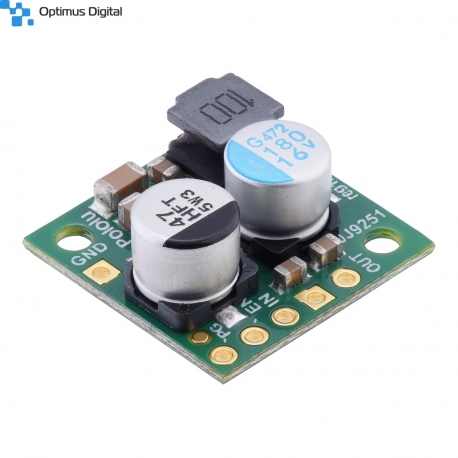 View larger
View larger
Pololu 12V, 2.2A Step-Down Voltage Regulator D24V22F12
0104110000010353
New product
This small synchronous switching step-down (or buck) regulator takes an input voltage of up to 36 V and efficiently reduces it to 12 V. The board measures only 0.7" x 0.7" yet delivers typical continuous output currents between 1.4 A and 2.2 A, depending on the input voltage, which makes this regulator well suited for powering moderate loads like sensors or small motors. An optional enable input can be used to put the regulator in a low-power state with a current draw of 5 µA to 10 µA per volt on VIN. The regulator also features reverse voltage protection and a power-good output indicates when the regulator cannot adequately maintain the output voltage.
See description for more details about the product.
Add to cart now!
3 Items
Warning: Last items in stock!
- Write a review
- Remove this product from my favorite's list.
- Add this product to my list of favorites.
More info

Overview
The D24V22Fx family of step-down voltage regulators generates lower output voltages from input voltages as high as 36 V. They are synchronous switching regulators (also called switched-mode power supplies (SMPS) or DC-to-DC converters) with typical efficiencies of 85% to 95%, which is much more efficient than linear voltage regulators, especially when the difference between the input and output voltage is large. These regulators can typically support continuous output currents between 1.4 A and 2.6 A, though the actual available output current is a function of the input voltage and efficiency (see the Typical efficiency and Maximum continuous output current sections below). In general, the available output current is a little higher for the lower-voltage versions than it is for the higher-voltage versions, and it decreases as the input voltage increases.
These regulators have a typical quiescent (no load) current draw of around 1 mA, and an enable pin can be used to put the boards in a low-power state that reduces the quiescent current to approximately 5 µA to 10 µA per volt on VIN.
The modules have built-in reverse-voltage protection, short-circuit protection, a thermal shutdown feature that helps prevent damage from overheating, and a soft-start feature that reduces inrush current.
The different voltage versions of this regulator all look very similar, so you should consider adding your own distinguishing marks or labels if you will be working simultaneously with multiple versions. This product page applies to all versions of the D24V22Fx family.
The D24V22Fx family is intended to replace our older D24V25Fx family of step-down voltage regulators. The two designs have the same size and similar current capabilities and input voltage ranges, but they do not have the same pinout and are based on different internal circuits, so there are fundamental differences in operation. In particular, these newer D24V22Fx regulators have much lower dropout voltages and provide a “power good” signal, and the newer design allows for higher output voltages (e.g. 12 V).
Features
• Input voltage:
○ 4 V to 36 V for the version that outputs 3.3 V
○ [output voltage + dropout voltage] to 36 V for output voltages of 5 V and higher (see the dropout voltage section for details)
• Fixed 3.3 V, 5 V, 6 V, 7.5 V, 9 V, or 12 V output (depending on regulator version) with 4% accuracy
• Typical maximum continuous output currents between 1.4 A abd 2.6 A (see the maximum continuous output current graph below)
• Typical efficiency of 85% to 95%, depending on input voltage, output voltage, and load (see the efficiency graph below)
• Switching frequency: ~400 kHz
• Integrated reverse-voltage protection, over-current and short-circuit protection, over-temperature shutoff, and soft-start
• 1 mA typical no-load quiescent current; this can be reduced to approximately 5 µA to 10 µA per volt on VIN by disabling the board (see the quiescent current graph below)
• "Power good" output indicates when the regulator cannot adequately maintain the output voltage
• Compact size: 0.7" x 0.7" x 0.31" (17.8 mm x 17.8 mm x 8 mm)
• Two 0.086" mounting holes for #2 or M2 screws
Using the regulator
Connections
These buck regulators have five main connection points for five different electrical nodes: power good (PG), enable (EN), input voltage (VIN), ground (GND), and output voltage (VOUT). The board also features a second ground connection point off the main row of connections that might be convenient for applications where you are soldering wires directly to the board rather than using it in a breadboard.
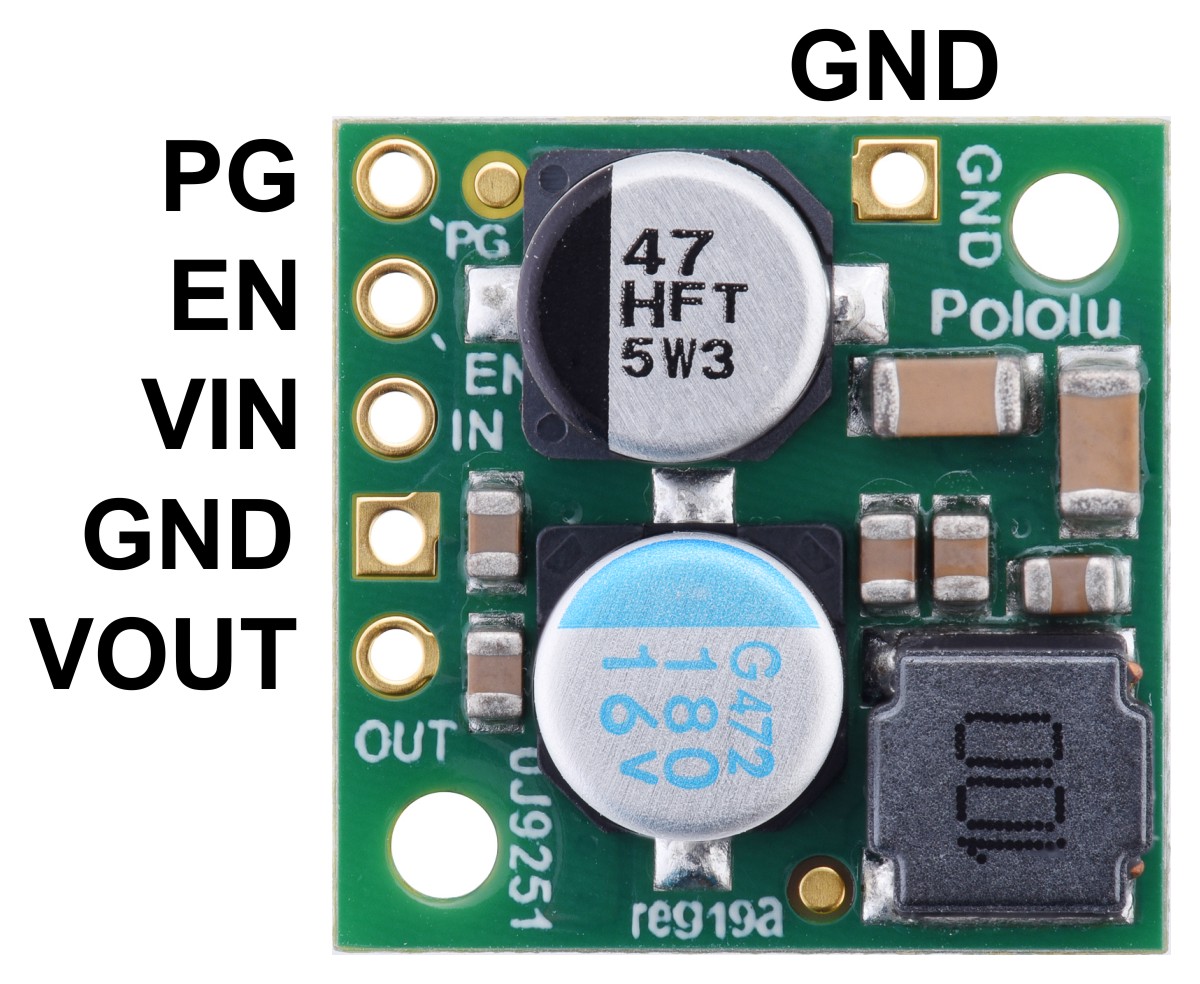
The input voltage, VIN, powers the regulator. Voltages between 4 V and 36 V can be applied to VIN, but for versions of the regulator that have an output voltage higher than 4 V, the effective lower limit of VIN is VOUT plus the regulator’s dropout voltage, which varies approximately linearly with the load (see below for a graph of dropout voltages as a function of the load).
The output voltage, VOUT, is fixed and depends on the regulator version: the D24V22F3 version outputs 3.3 V, the D24V22F5 version outputs 5 V, the D24V22F6 version outputs 6 V, the D24V22F7 version outputs 7.5 V, the D24V22F9 version outputs 9 V, and the D24V22F12 version outputs 12 V.
The regulator is enabled by default: a 270 kΩ pull-up resistor on the board connects the EN pin to reverse-protected VIN. The EN pin can be driven low (under 1 V) to put the board into a low-power state. The quiescent current draw in this sleep mode is dominated by the current in the pull-up resistor from EN to VIN and by the reverse-voltage protection circuit, which altogether will draw between 5 µA and 10 µA per volt on VIN when EN is held low. If you do not need this feature, you should leave the EN pin disconnected.
The "power good" indicator, PG, is an open-drain output that goes low when the regulator’s output voltage falls below around 85% of the nominal voltage and becomes high-impedance when the output voltage rises above around 90%. An external pull-up resistor is required to use this pin.

Pololu Step-Down Voltage Regulator D24V22Fx with included hardware.

Pololu Step-Down Voltage Regulator D24V22Fx with included hardware.
The five main connection points are labeled on the top of the PCB and are arranged with a 0.1" spacing for compatibility with solderless breadboards, connectors, and other prototyping arrangements that use a 0.1" grid. Either the 5x1 straight male header strip or the 5x1 right angle male header strip can be soldered into these holes. For the most compact installation, you can solder wires directly to the board.
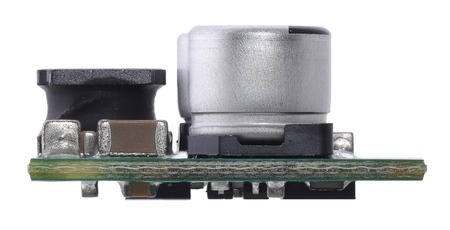
Pololu Step-Down Voltage Regulator D24V22Fx, side view.
The board has two 0.086" (2.18 mm) diameter mounting holes intended for #2 or M2 screws. The mounting holes are at opposite corners of the board and are separated by 0.52" (13.21 mm) both horizontally and vertically. For all the board dimensions, see the dimension diagram (204k pdf).
Details
Typical efficiency
The efficiency of a voltage regulator, defined as (Power out)/(Power in), is an important measure of its performance, especially when battery life or heat are concerns. This family of switching regulators typically has an efficiency of 85% to 95%, though the actual efficiency in a given system depends on input voltage, output voltage, and output current. See the efficiency graph below for more information.

Typical dropout voltage
The dropout voltage of a step-down regulator is the minimum amount by which the input voltage must exceed the regulator’s target output voltage in order to ensure the target output can be achieved. For example, if a 5 V regulator has a 1 V dropout voltage, the input must be at least 6 V to ensure the output is the full 5 V. Generally speaking, the dropout voltage increases as the output current increases. The graph below shows the dropout voltage at different output currents for the D24V22F12.
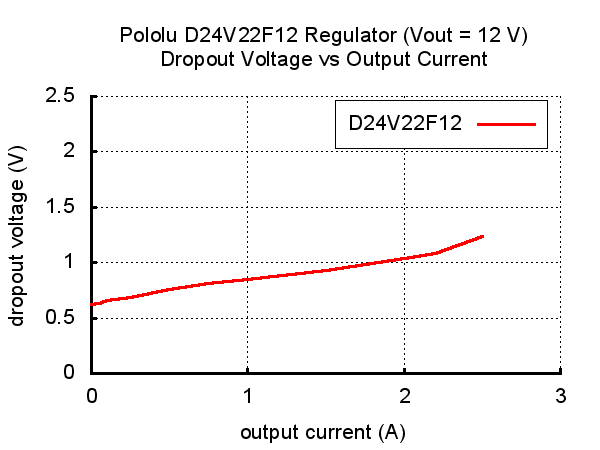
Maximum continuous output current
The maximum achievable output current of these regulators varies with the input voltage but also depends on other factors, including the ambient temperature, air flow, and heat sinking. The graph below shows maximum output currents that these regulators can deliver continuously at room temperature in still air and without additional heat sinking.
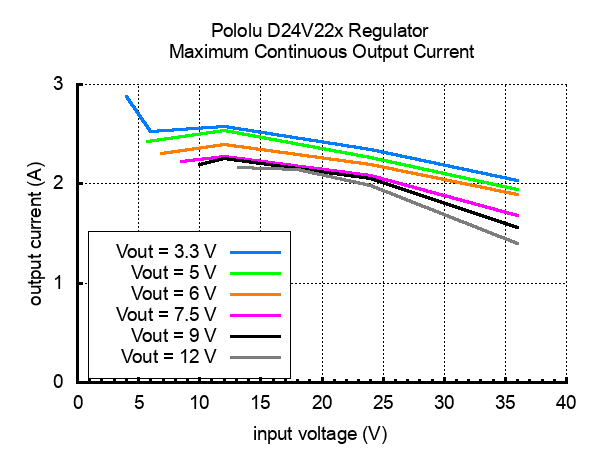
Quiescent current
The quiescent current is the current the regulator uses just to power itself, and the graph below shows this for the different regulator versions as a function of the input voltage. The module’s EN input can be driven low to put the board into a low-power state where it typically draws between 5 µA and 10 µA per volt on VIN.
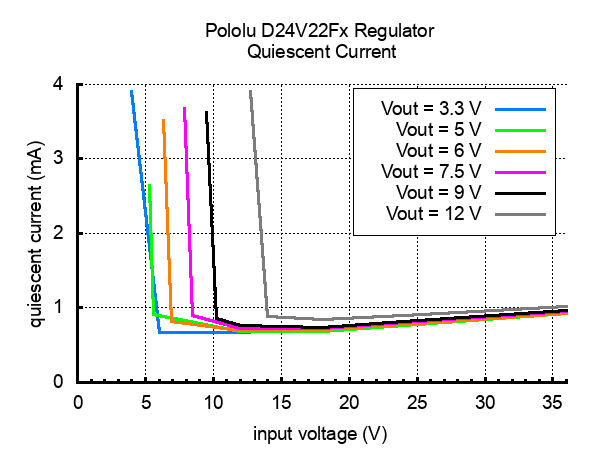
Specifications
Dimensions
| Size: | 0.7" x 0.7" x 0.31"1 |
| Weight: | 2.3 g1 |
General specifications
| Minimum operating voltage: | 12.7 V2 |
| Maximum operating voltage: | 36 V |
| Continuous output current: | 1.9 A3 |
| Output voltage: | 12 V |
| Reverse voltage protection?: | Y |
| Maximum quiescent current: | 4 mA4 |
Notes:
1 Without included optional headers.
2 For small loads; this voltage rises approximately linearly up to around 13.1 V at 2.2 A output.
3 Typical continuous output current at 24 V in. Actual achievable continuous output current is a function of input voltage and is limited by thermal dissipation. See the output current graph under the description tab for more information.
4 Typical worst case; quiescent current is typically around 1 mA for most of the operating range. The ENABLE pin can be used to reduce the quiescent current to less than 10 μA per volt on VIN.
Don't delay. Buy today.
Add to cart now!
Reviews
Customers who bought this product also bought:
-
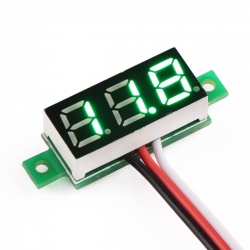
4.5 - 30 V...
This is a 0 - 30 V green panel voltmeter...
$2.64
-
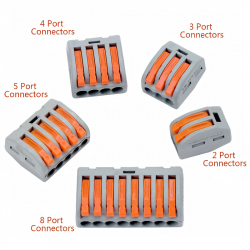
PCT-2-112...
PCT-2-112 Wire Connector See description for...
$0.31
-
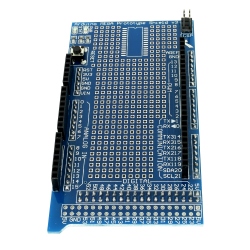
Proto Shield...
This is a Proto Shield for Arduino Mega 2560...
$5.97
-
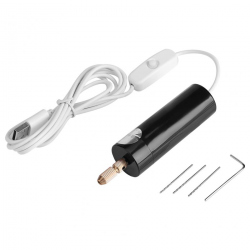
Mini USB...
Mini USB Powered Drill See description for...
$8.40
-
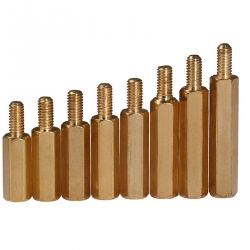
5*6 mm Metal...
Hexagonal threaded spacers are Perfect for...
$0.72
-
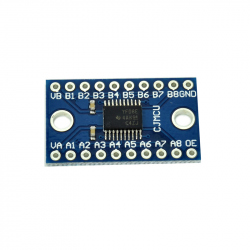
TXS0108E 8...
This product is a bi-directional logic level...
$1.56
-
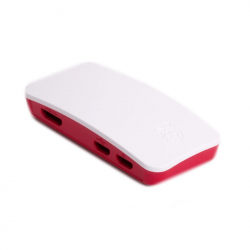
Raspberry Pi...
Raspberry Pi Zero/W case useful for protecting...
$5.14
-
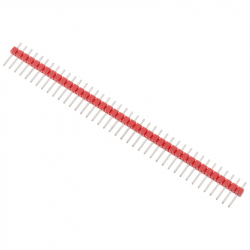
Colored 40p...
Colored 40p 2.54 mm Pitch Male Pin Header - Red...
$0.24
-
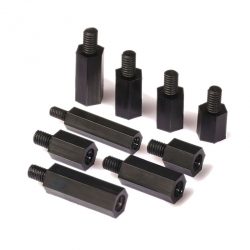
10*6 mm...
10*6 mm Black M3 Hex Pillar
$0.24
-
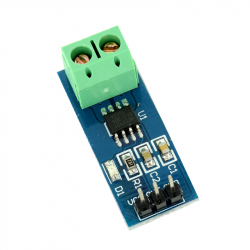
ACS712 30 A...
ACS712 30 A Current Sensor See description for...
$3.60








